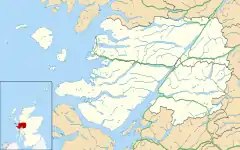Lochaline
Lochaline (Scottish Gaelic: Loch Àlainn) is the main village in the Morvern area of Highland, Scotland. It is situated at the mouth of Loch Aline, on the northern shore. Lochaline is connected with Fishnish on the Isle of Mull by ferry.
Lochaline
| |
|---|---|
 Lochaline | |
 Lochaline Location within the Lochaber area | |
| OS grid reference | NM6744 |
| Civil parish | |
| Council area | |
| Lieutenancy area | |
| Country | Scotland |
| Sovereign state | United Kingdom |
| Post town | OBAN |
| Postcode district | PA80 |
| Dialling code | 01967 |
| Police | Scotland |
| Fire | Scottish |
| Ambulance | Scottish |
| UK Parliament | |
| Scottish Parliament | |

Geology
There has been a silica sand mine in Lochaline since 1940 when it was opened to replace sources of silica lost because of World War II.[1] A source was needed for the manufacture of optical quality glass. It was announced in November 2008 that the mine would be closing.[2]
In October 2011 it was announced that the mine would re-open in 2012 under a new company. Interviews for various positions within the mine are set to take place in the early months of 2012.
The silica quartz and other minerals came from the erosion of the Scottish landmass. They were deposited on the shore of a tropical sea on Jurassic shales and limestones in the middle of the Cretaceous period, 93 million years ago, at the same time the chalk cliffs of Dover were forming. The sandy sediment was reworked by frequent changes to sea level. Natural winnowing processes sorted the quartz from other minerals, separating grains of similar size. For 60 million years this was protected from erosion by a basalt covering from the Mull volcano.
Near the loch shoreline today are fossil oysters, or Gryphaea, that lived on the shoreline of a tropical sea here 200 million years ago.[3] The rocks in this layer are the same age as the Jurassic Coast in Dorset.
St Kilda
In August 1930 the last inhabitants of the archipelago of St Kilda were evacuated by Williamina Barclay. They made their way to Lochaline where many lived and settled with some difficulty.[4]
Attractions
The village is popular with divers due to its proximity to the wrecks of the Sound of Mull, with various charter boats available locally.
The village has a snack bar adjacent to the ferry slipway, a shop, post office, restaurant, hotel, social club and marina.
See also
References
- Exploring Morvern, Morvern Heritage Society, The Story of Lochaline Silica Mine, Mary Barnes, pages 14–19
- £Mine closes with loss of 11 jobs" Lochaber News, 20 November 2008]
- The Evolution of Gryphaea, Stephen Jay Gould, 1980.
- The new biographical dictionary of Scottish women. Ewan, Elizabeth. Edinburgh. ISBN 9781474436298. OCLC 1057237368.CS1 maint: others (link)
